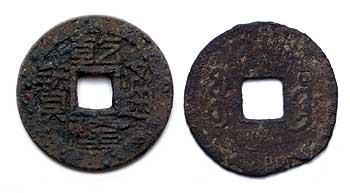Japanese Yen
We thought at first this was a Chinese coin when we found it, but then were informed via an Email that it is a Japanese yen.

We have looked all over looking for the history of the Japanese Yen. But haven't found much. The Yen is the basic coin in Japan just like the penny is the basic coin in America. The 5 Yen coin has a hole in the middle of it. The 50 Yen coin also has a hole in the middle of it. A long time ago, men carried these coins with a hole in the middle of them around their necks tied together with a string. There is a 10 yen coin. There is also a 100 yen coin and a 500 yen coin. Japanese paper money usually comes in 1,000 yen amounts and 10,000 yen amounts.
History of the Japanese Yen
Prior to the Meiji currency reform, there was no fixed exchange rate between the various silver, gold and copper cash coins. (which previously included the Chinese Cash) in circulation. Each coin exchanged on the basis of it's own merits, and the prevailing market conditions. The weight and size of the coinage varied widely, and occasionally the government would declare an official exchange rate, but this was usually ignored. The history of Japan is lost in legend. The divine design of the empire, supposedly founded in 660 B.C. by the emperor Jimmu, a lineal descendant of the sun goddess and ancestor of the present emperor, was held as official dogma until 1945. Actually, reliable records date back only to about A.D. 400. In the first centuries of the Christian era the country was inhabited by numerous clans or tribal kingdoms ruled by priest-chiefs. Contacts with Korea were close, and bronze and iron implements were probably introduced by invaders from Korea around the 1st cent.
By the 5th cent. the Yamato clan, whose original home was apparently in Kyushu, had settled in the vicinity of modern Kyoto and had established a loose control over the other clans of central and W Japan, laying the foundation of the Japanese state.The first European contact with Japan was made by Portuguese sailors in 1542. A small trade with the West developed.
Christianity was introduced by St. Francis Xavier, who reached Japan in 1549. The yen (en) was established as the official unit of currency in 1871. The name en was used because it means round, as opposed to the oblong shape of previous coinage. One hundredth of a yen is called a sen, although this unit is so small that it is only mentioned today in the financial markets. The Bank of Japan, established in 1882, issued its first bank notes in 1885.
The 500, 100 and 50 yen coins are made of nickel, the 10 yen of bronze, the 5 yen of copper and the 1 yen of aluminium. With holes through the center, the 50 yen and more often the 5 yen coin are considered lucky and often used in charms. (CUDA)
Chinese Cash Coins
 We have a couple of these Chinese Cash Coins now, so we might as well add them to the list. Both were found on a riverbank, but not even close to the same location.
We have a couple of these Chinese Cash Coins now, so we might as well add them to the list. Both were found on a riverbank, but not even close to the same location.
We were told that there were a lot of these made, and that they were secured onto the products that were imported from China. Is this true? We don't know.
They say there were so many of them in this country that the children used them for play money. But we like finding them, that's for sure.History Chinese Cash Coins
Before 1912, China was ruled by an imperial government. Ming Dynasty coinage was from 1368 to 1644. They are called Shen Tsung coinage from 1573 to 1619.
During the reign of Shen Tsung, the Board of Revenue and Works were ordered to produce the Wan-li-Tong-bao cash pieces in 1576. The reverse of these cash pieces include a dot, crescent, Kung(two types), Cheng, Tien, Fen, Li, and muled obverse.
Subsequently due to the large scales of war and famine, military authorities, provinces, and private sources, minted similar coins in large quantities, including a 2, 5, 10, cash pieces. There are many varieties of Cash coins and you would need a book to identify the ones you found. But they are easily identified because the obverse has a special mark or character for each different coin.Foreign Coin Websites
The Value of Money